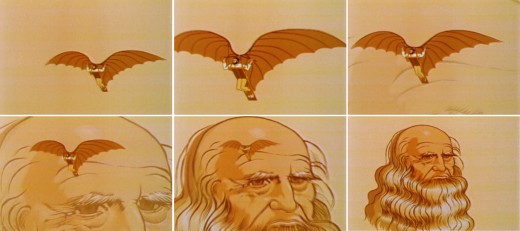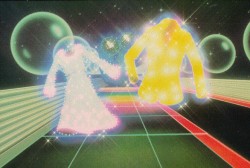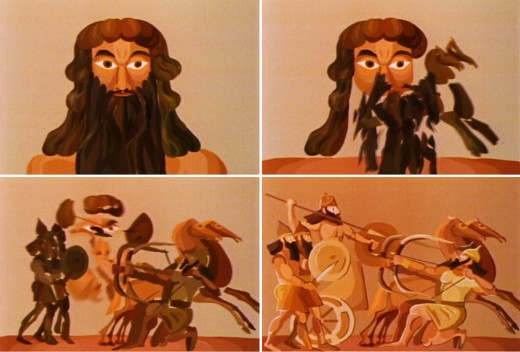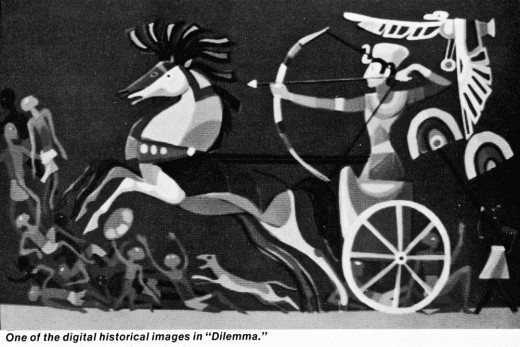Articles on Animation 07 Feb 2009 09:34 am
Dilemma
John Halas was always an advocate for computer animation. He wrote about it long before there was any visible signs of success and he produced some early films using available technology. In 1981, in conjunction with Computer Creations, he produced a 10 min. film done completely digitally.
Computer animation, in those days, was rather priimitive. 6 years earlier, Peter Foldes with his film, Hunger, had offered wire-frame imagery that was didn’t really suggest to character animators the revolution to come. Perhaps Dilemma did, though it didn’t get the attention it might have.

A scene from the film attempts some animation as the winged man
slowly moves his wings up and down as he recedes into Leonardo’s head.
Rather than try to create 3D dolls, the filmmakers were attempting to do graphic animation. There’s nothing in the way of character animation in the piece, though there is a lot of machinery and gears moving and turning. They attempt to tell a story using a lot of morphing graphics and electronic music and sounds.
 Within a couple of years, Abel Associates and PDI were producing a lot of shiny things and silver robots animating – change that to moving on the commercials for Levis and cars.
Within a couple of years, Abel Associates and PDI were producing a lot of shiny things and silver robots animating – change that to moving on the commercials for Levis and cars.
Only 11 years after Dilemma, Pixar would offer Toy Story. Little Viewmaster-like dolls took over computer animation and sealed the near future.
Here’s an article that appeared in a 1981 issue of Millimeter that talks about Dilemma.
by Jim Lindner
Attempting a 10-minute film produced entirely with the assistance of digital computers in the style of traditional animation could send chills up the spine of even the most stalwart animator. Complicate matters by having the film contain over 160 scenes, special effects that include three dimensional simulation, utilize several thousand separate colors, produce the film from start to finish in less than two months, and you have a project that most would consider highly improbable. Such a film, however, is being produced as a joint effort of international scope between Halas & Batchelor Animation Ltd. of London, and Computer Creations of South Bend, Indiana, and New York.
“Dilemma” is a story of evolution; an evolution of intellect and achievement, and of the evolution of destructive capability. Indeed, man has often used his most powerful technological achievements as tools of destruction. The film portrays the progression of this evolution and the resulting dilemma between the application of technology for artistic or destructive intent. The implications of such devastation are clearly global, and it seems appropriate that the film be produced for and distributed by The United Nations General Assembly.
John Halas (veteran animator for over 40 years, producer of over 600 films, and the author of many books and articles on animation) is the visual designer behind the film for Halas & Batchelor in London. When asked why digital computer animation is being utilized for such a project, Mr. Halas responds that “There is no doubt that computer animation has potential to be exploited, and its impact will be felt in all aspects of visual
communication. In this case an approach that could deliver the art style inherent in Janos Kass’ [sculptor and designer whose work provided the inspiration for the film] design was required.”
Computers and animation are nothing new for Halas. In 1974, he wrote that “Artists and designers must come to terms with the computer as they must other gadgets operated by electricity, and if they seriously want to utilize the values and facilities, they obviously must learn to use the computer in much the same way they are using pencils, pens, and brushes.”
Working with John Halas was the Computer Creations team of president Tom Klimek, and senior art director Eric Brown. The challenge was clearly to accomplish such an ambitious undertaking within budget and within a very tight time deadline. Mr. Halas said that the normal productdion requirements for a job of this nature would take “ten full-time workers a minimum of eight months.” Mr. Halas adds that “Because of the reduced time and labor requirements, substantial cost savings have been achieved.”
The process utilized to produce “Dilemma” is known as VideoCel® and is purely digital in nature. There are no cameras, although the images have depth and perspective in full color and are not limited to moving colored lines. The actual artwork is entered into the computer by the artist, using an electronic tablet. The artist provides the coloring and timing instructions by answering simple-questions posed by the computer in ordinary English. In this fashion, the.artist is totally in control, with the engineers and programmers waiting in the wings should their assistance be required. The computer keeps track of all the colors, shapes, areas, and movements, exactly as transmitted by the skilled hand (and style) of the artist. The artist can view the work and modify the instructions for any part of the work at any time. When each scene has been completed, the computer draws each frame (over 18,000 for “Dilemma”), calculating the values for the over 250,000 colored points required for each individual frame.

Here’s an example of the often-used morphing technique that the
filmmakers use to move their story forward.
The images presented in “Dilemma” represent a cross between character animation /and three-dimensional graphic simulation. Several scenes are a computer-generated blend from one scene to another. Images swing and change position in dimension and recombine to produce entirely different pictures and scenes. In other sections of the film, objects delicately form and move about the screen in an abstract form eventually shifting to elements within the story. Still other scenes show fantasy space demons of the future being propelled through space in dimension.
One of the most interesting aspects of “Dilemma” is its pacing. While some sections are gracefully paced and balanced, other scenes race by with the urgency of the theme being conveyed by movement and design. Throughout the film, color is used in a fashion similar to that of conventional eel animation, with subtlety being the emphasis as opposed to high color or the typical glowing lines that have become so popular. With “Dilemma,” the computer has been successfully utilized as a design instrument with the design being determined by the artist — not by machine.
You can watch a clip of this film here.
.


on 07 Feb 2009 at 5:08 pm 1.Niffiwan said …
Thanks. Very interesting! I wish it was possible to view the film somewhere.
An IMDB reviewer mentions that he tracked down a DVD that had the film, but I can’t seem to find its name through Google.
on 25 Sep 2010 at 3:18 pm 2.Dilemma said …
” Dilemma” film’s storyboard and design by KASS János (Janos KASS)